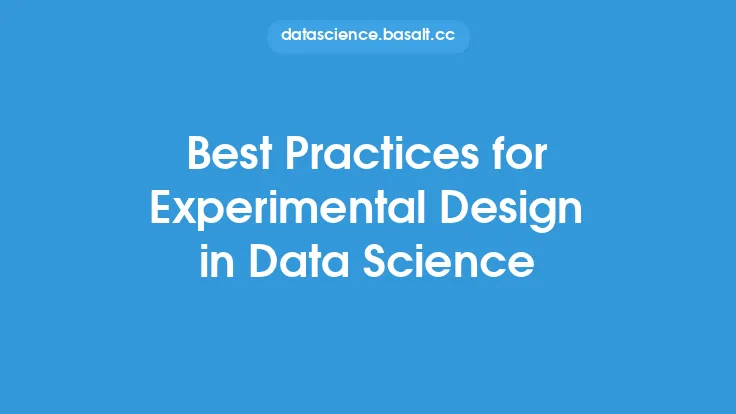When it comes to data science initiatives, data storage is a critical component that can make or break the success of a project. With the exponential growth of data, it's essential to have a well-planned data storage strategy in place to ensure that data is stored, managed, and retrieved efficiently. In this article, we'll delve into the best practices for data storage in data science initiatives, exploring the key considerations, technologies, and techniques that can help organizations get the most out of their data.
Introduction to Data Storage in Data Science
Data storage in data science refers to the process of storing, managing, and retrieving data in a way that supports data analysis, machine learning, and other data-intensive applications. Effective data storage is crucial for data science initiatives, as it enables data scientists to access and manipulate large datasets, perform complex analytics, and build predictive models. A well-designed data storage system can help organizations to improve data quality, reduce data redundancy, and increase data accessibility, ultimately leading to better decision-making and business outcomes.
Key Considerations for Data Storage in Data Science
When designing a data storage system for data science initiatives, there are several key considerations to keep in mind. These include:
- Data Volume: The amount of data that needs to be stored, which can range from a few gigabytes to several petabytes.
- Data Variety: The different types of data that need to be stored, such as structured, semi-structured, and unstructured data.
- Data Velocity: The speed at which data is generated, processed, and analyzed, which can impact the performance and scalability of the data storage system.
- Data Security: The measures that need to be taken to protect data from unauthorized access, theft, or corruption.
- Data Governance: The policies, procedures, and standards that need to be established to ensure data quality, integrity, and compliance.
Data Storage Technologies for Data Science
There are several data storage technologies that can be used for data science initiatives, each with its own strengths and weaknesses. These include:
- Relational Databases: Traditional databases that use structured query language (SQL) to store and manage data, such as MySQL, Oracle, and Microsoft SQL Server.
- NoSQL Databases: Non-relational databases that use flexible schema designs to store and manage large amounts of unstructured or semi-structured data, such as MongoDB, Cassandra, and Couchbase.
- Data Warehouses: Centralized repositories that store data from various sources in a single location, making it easier to access and analyze, such as Amazon Redshift, Google BigQuery, and Microsoft Azure Synapse Analytics.
- Data Lakes: Scalable repositories that store raw, unprocessed data in its native format, making it easier to perform big data analytics and machine learning, such as Apache Hadoop, Apache Spark, and Amazon S3.
- Cloud Storage: Cloud-based storage solutions that provide scalable, on-demand storage for data, such as Amazon S3, Microsoft Azure Blob Storage, and Google Cloud Storage.
Best Practices for Data Storage in Data Science
To get the most out of data storage in data science initiatives, there are several best practices to follow. These include:
- Use a Scalable Data Storage System: Choose a data storage system that can scale to meet the growing needs of your organization, such as a cloud-based data warehouse or a distributed file system.
- Implement Data Governance: Establish policies, procedures, and standards to ensure data quality, integrity, and compliance, such as data validation, data normalization, and data encryption.
- Use Data Compression and Encryption: Use data compression and encryption to reduce storage costs and protect data from unauthorized access, such as gzip, lz4, and AES-256.
- Optimize Data Retrieval: Optimize data retrieval by using indexing, caching, and query optimization techniques, such as creating indexes on frequently accessed columns, using caching layers like Redis or Memcached, and optimizing SQL queries using EXPLAIN and ANALYZE.
- Monitor and Maintain Data Storage: Monitor and maintain data storage systems to ensure they are running efficiently and effectively, such as monitoring disk usage, CPU usage, and network latency, and performing regular backups and maintenance tasks.
Data Storage Security and Compliance
Data storage security and compliance are critical considerations for data science initiatives, as they can impact the confidentiality, integrity, and availability of data. To ensure data storage security and compliance, organizations should:
- Implement Access Controls: Implement access controls, such as authentication, authorization, and auditing, to ensure that only authorized personnel can access and manipulate data.
- Use Encryption: Use encryption to protect data from unauthorized access, such as encrypting data at rest and in transit using SSL/TLS or IPsec.
- Comply with Regulations: Comply with regulations, such as GDPR, HIPAA, and PCI-DSS, by implementing data protection policies, procedures, and standards.
- Perform Regular Backups: Perform regular backups to ensure that data can be recovered in case of a disaster or data loss, such as using backup tools like rsync, tar, or backup software like Veritas or Commvault.
Conclusion
In conclusion, data storage is a critical component of data science initiatives, and organizations need to have a well-planned data storage strategy in place to ensure that data is stored, managed, and retrieved efficiently. By following best practices, such as using scalable data storage systems, implementing data governance, and optimizing data retrieval, organizations can get the most out of their data and drive business success. Additionally, by prioritizing data storage security and compliance, organizations can protect their data from unauthorized access, theft, or corruption, and ensure that they are meeting regulatory requirements.





